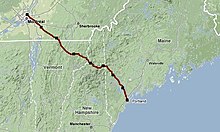Portland–Montreal pipeline
| Portland–Montreal Pipe Line | |
|---|---|
 Portland Pipeline marine terminal in South Portland, ME | |
 Map of Portland–Montreal Pipe Line | |
| Location | |
| Country | United States Canada |
| From | South Portland, Maine, United States |
| To | Montreal, Quebec, Canada |
| General information | |
| Type | Crude oil |
| Operator | Portland Pipe Line Corporation (in the United States) Montreal Pipe Line Limited (in Canada) |
| Commissioned | 1941 |
| Technical information | |
| Length | 236 mi (380 km) |
| Diameter | 24 in (610 mm) |
The Portland Montreal Pipe Line is a series of underground crude oil pipelines connecting South Portland, Maine, in the United States with Montreal, Quebec, in Canada.
History

The pipeline traces its history to the early years of World War II when oil shipments to Canada were severely disrupted by the Kriegsmarine during the Battle of the St. Lawrence and the larger Battle of the Atlantic. In order to safely transport oil to central Canada, a pipeline was proposed to connect the relatively secure Port of Portland in Maine with refineries in Montreal.
The marine terminal was built on the south side of the Fore River in the city of South Portland immediately downstream of the Portland Terminal Company's railroad bridge over the river. The pipeline route from Portland to Montreal was mostly built alongside the existing right of way for the Portland - Montreal rail line which was owned at that time by the Canadian National Railways (CNR) and called the CNR's Berlin Subdivision. This rail line was built in the 1850s by the Atlantic & St. Lawrence Railroad which was purchased by the Grand Trunk Railway shortly after completion. The Grand Trunk Railway encountered financial difficulties after World War I and the company was nationalized by the Government of Canada in 1923 with its properties merged into the CNR.
Construction of the original pipeline was finished in 1941, and the transportation of oil to Montreal began. The pipeline originally consisted of three separate pipes, which crossed through the same common right-of-way. Today only two pipes operate after they underwent renovation. The third and smallest pipe was decommissioned in 1982. Since it has been in service, the pipeline has pumped over 4 billion barrels (640,000,000 m3) of oil to Montreal refineries.[1] The pipeline is the primary reason that the Port of Portland is the largest volume oil port on the Eastern Seaboard, as more than 200 tankers deliver oil to the pipeline marine terminal annually.[2]
Details
Oil is transported by oil tankers to South Portland, where it is pumped ashore to a 100-acre (0.40 km2) tank farm along South Portland's waterfront. The facility includes 23 oil tanks and a capacity of 3.5 million barrels (560,000 m3) of crude oil. The oil is then pumped through two separate pipelines, one which is 18 inches (460 mm) in diameter and another which is 24 inches (610 mm) in diameter.[3] The pipeline extends 236 miles (380 km), 3 feet (0.91 m) beneath the surface, and has several pump stations distributed throughout the line. The pipeline crosses into the mountains of New Hampshire and Vermont, eventually passing under the St. Lawrence River, extending into Montreal. From South Portland to Montreal, it takes between 36–43 hours for the oil to reach its destination, where it is processed in one of two refineries.[4]
There is a third decommissioned line, 12 inches (300 mm) in diameter. Lines not being used are filled with nitrogen, an inert gas.[5]
Expansion and line reversal proposal
The Portland Pipe Line Corporation/Montreal Pipe Line Limited announced in February 2008 that it was studying a proposal to expand and/or reverse the flow of the Portland–Montreal Pipe Line. Crude oil reserves are undergoing increased development in western Canada, namely raw bitumen from the Athabasca oil sands deposit, also known as the Alberta Tar Sands. The pipeline owner alleges that the proposed plan would open up international markets to Canadian petroleum companies and would require an estimated $100 million in modifications to the pipeline and South Portland marine terminal facilities.[6]
References
- ^ ::Portland Montreal Pipe Line:: About us
- ^ Pipeline pondering flow change, Portland Press Herald
- ^ ::Portland Montreal Pipe Line:: Neighborhood guide
- ^ Portland Pipeline
- ^ Braithwaite, Chris (September 28, 2011). "Exposed pipeline is safe, company says". the Chronicle. Barton, Vermont. p. 3.
- ^ MaineToday.com | News Update: Firm will study bringing oil from Canada
Sources
- "Portland-Montreal Pipe Line Honored for Maritime Protection", Association of Oil Pipe Lines/American Petroleum Institute, Dec. 2004
